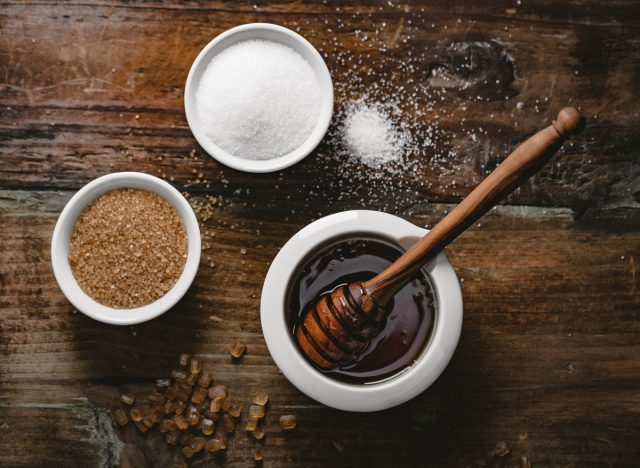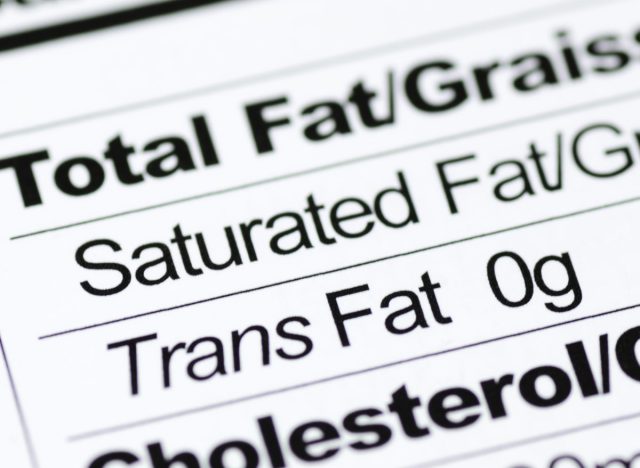Have you ever planned out your grocery shopping trip with every ounce of hope and motivation that you'll go and get the most delicious, nutrient-dense food, only to get there and be discouraged by the endlessly confusing jargon written on the food packages? Organic, non-GMO, natural, added sugars, sodium, saturated and unsaturated fats…there is so much to pay attention to when it comes to buying food, that even when we have the best of intentions for making healthy decisions, we can feel easily discouraged by these labels.
Thankfully, you're not alone in this struggle, which is why we talked with two dietitians from our Medical Expert Board—Amy Goodson, MS, RD, CSSD, LD, author of The Sports Nutrition Playbook, and Sydney Greene, MS, RDN—to learn more about what they would consider as red flags when looking over nutrition labels. Below, they help us narrow down some of the common ingredients you'll want to look out for and steer clear of while shopping for groceries, and even identify some common misleading marketing tactics used by food companies to persuade you to buy their products. Read on to find out which nutrition label red flags you'll want to remain on guard for and avoid.
More than a few grams of added sugar

Many of us are aware of the frustrations that come from feeling like every item of food we try buying has some form of sugar in it. It feels like we can't get away from it, even in items that we would assume wouldn't have it, like salad dressings or sauces. And while we may not be able to stay away from sugar completely (nor would we want to because it's delicious), dietitians say that there are specific things you can look for on nutrition labels. When it comes to sugar, one red flag is if there are more than a few grams.
"There is not a set number for added sugar on a nutrition facts label that you should pay attention to, my dietitian rule of thumb is look for foods with only a few grams of added sugar or less," says Goodson.
Another thing to watch out for is if sugar is the first ingredient on the list. This could indicate that there is possibly more sugar in the item than other ingredients.
"Unless you are buying candy or a baked good, sugar should not be the first ingredient in packaged foods like protein bars, cereals, or even condiments," says Greene.
Something that can be even more discouraging than the amount of added sugars you might see on nutrition labels is the sneaky ways labels sometimes refer to the names of certain ingredients. To help you see through some of these "disguises," Goodson sets the record straight about some common euphemisms used for "added sugars."
"Ingredients that count as added sugar are sugar, cane sugar, fructose, high-fructose corn syrup, corn syrup, honey, agave nectar, maple syrup, molasses, dextrose, maltodextrin, turbinado, and rice syrup—just to name a few," says Goodson.
"There are over 60 different names for sugar," Greene continues. "So, it is important to research ingredients that you are unsure of. If you see an ingredient with "syrup" in the name or a word ending in '-ose,' you can assume it is most likely sugar. Examples of the sneakiest ones are brown rice syrup, any form of fruit juice, barley malt, or coconut nectar."
Grains without fiber
Fiber is a crucial nutrient to have on a regular basis. It is known for helping lower LDL (or "bad") cholesterol and aid in weight management. According to Greene, "[Fiber] is also important for digestion, blood sugar balance, and overall health."
Fruits and vegetables can be an excellent source of fiber, but another easy way to consume this nutrient is through grain products like whole grain bread, cereals, and pastas. Unfortunately, an enormous red flag to keep you is a grain product that contains zero fiber on the nutrition label.
"If you are shopping for granola bars, crackers, pasta, cereal, waffles, bread, bagels, and the like, and the nutrition facts label has zero grams of fiber, put that brand up and look for a whole grain brand," says Goodson. "Foods that should have fiber (like whole grains), but have zero grams listed on the label mean that food has been overly processed," says Greene.
Larger amounts of saturated fat

You may have been taught to check the fat content on the back of food labels, but Goodson says that saturated fat is where your eyes need to go.
"Large intakes of saturated fat consumed on a regular basis can contribute to an increase in LDL ('bad') and total cholesterol," says Goodson. "Typically, saturated fat is found in baked goods, higher-fat red meat, creamy sauces and spreads, and some packaged snack foods."
The American Heart Association recommends keeping your intake of saturated fat to around 13 grams for an entire day, but Goodson offers a great tip that can help you avoid bringing foods home that could make you susceptible to going over this amount.
"When you look at the food label, try to choose foods with 1 gram of saturated fat or less per serving," Goodson suggests. This way, you can avoid getting too close (or totally going over) the limit in one sitting.
Sneaky front-of-package claims
"While there are regulations as to what can be put on the front of package in regards to health and nutrition claims, it is still necessary to flip the package over and check out the label and ingredient list for yourself," explains Goodson.
For example, even if a product's package says "whole wheat" on the front, this does not guarantee that it's healthy and entirely whole wheat.
"A product might say 'whole wheat' on the package, but then the first ingredient can be 'enriched wheat flour,' a processed type of wheat flour," says Goodson. "This is because if a product actually had 'whole wheat flour,' as their first ingredient, the front of the package would have to say '100% whole wheat.'"
Another tricky red flag you may catch when reading nutrition labels is when an item claims to contain "less" of something (i.e., less sugar, less fat, less sodium, and so on).
"When a snack food says '25% less fat' on the front of the package, that means '25% less fat in relation to the regular version of that product'—not all of products in that food category," says Goodson.
In other words, while we might be inclined to believe there isn't a significant amount of fat in a given snack based on this type of marketing messaging that is used. However, there is still a possibility that the product in question could actually be high in fat—as long as it's less fat than its "regular" iteration, companies are able to make this sort of claim.
Jargon like 'organic' or 'all-natural'

It's understandable that words like "organic" or "natural" can lead someone to automatically assume an item is nutrition and healthy. However, our dietitians warn that this could be a red flag for some products. In actuality, these products may not necessarily be good for you at all.
"The term 'all-natural' appears on many products, but neither the USDA nor the FDA have strict guidelines on what this means. This label can be misleading because it does not mean there is any nutritional benefit," says Greene. "For example, granola could be made with 'all-natural' ingredients like oats, oil, coconut, and maple syrup—but the amount of sweetener used in production could be so high that the granola is more like a dessert than a breakfast food."
The same can be said about something that is labeled as "organic."
"Many people believe that foods marked as 'organic' are better for you nutritionally, but this isn't the case," says Goodson. "The 'organic' claim has to do with how an animal product was raised, how another product was manufactured, or what farming practices were used—meaning it's less about what's in the product, and more about how the product was made or raised."
To be clear, this doesn't mean that everything that's considered as organic is bad for you by any means. However, Goodson reminds us that "looking for organic is a personal preference, and you can still eat just as healthy by purchasing conventional food, too."
At the end of the day, these nutrition label red flags are just a way to help you have more confidence and knowledge when you're in a grocery store full of intentionally confusing words and lingo. With these tips mentioned above, you can hopefully know what to avoid or what needs more careful attention the next time you're faced with a red flag.
No comments:
Post a Comment